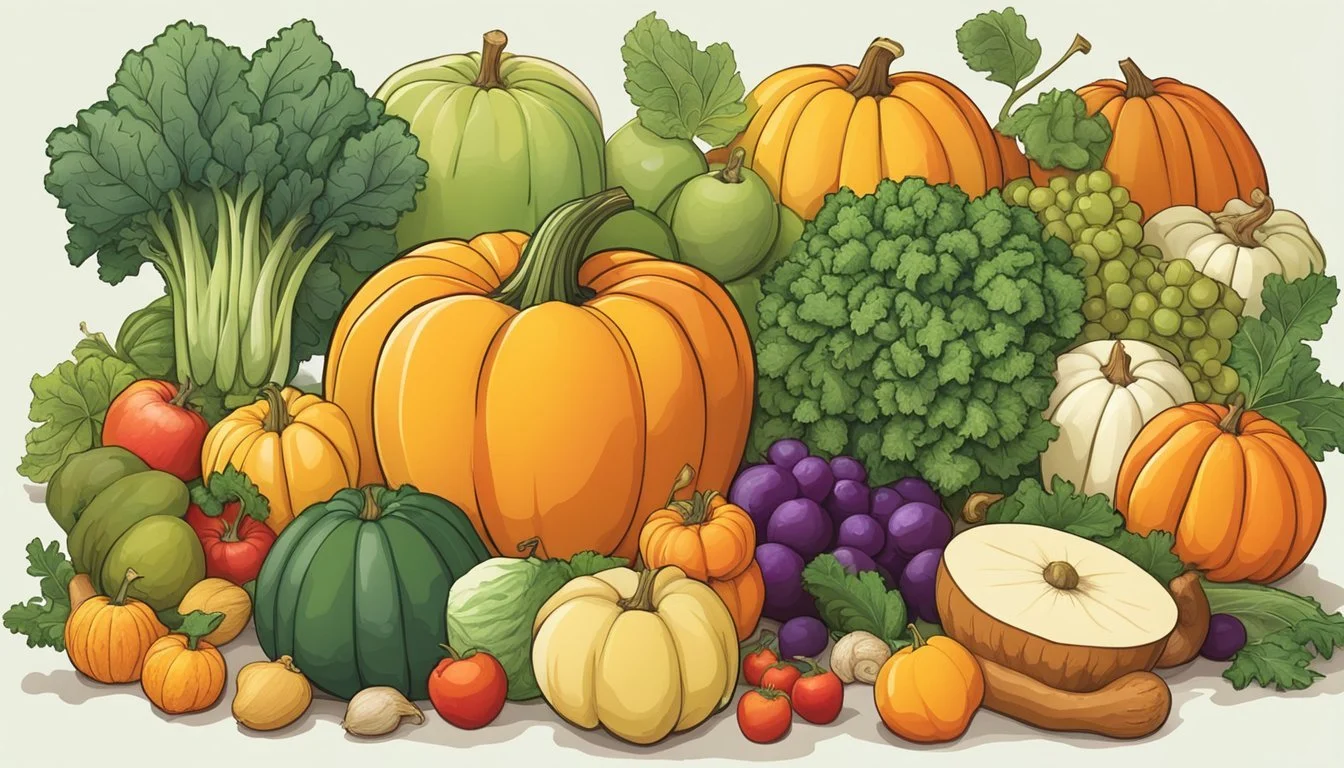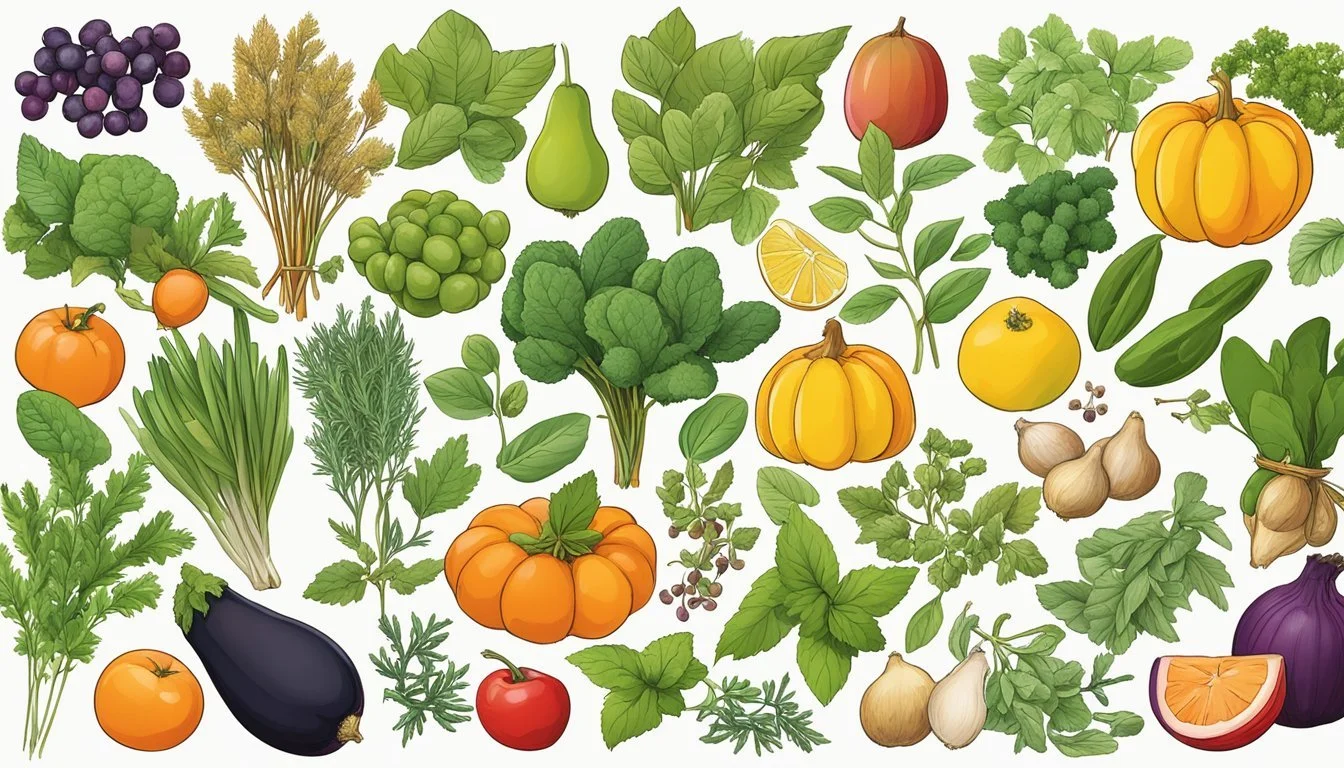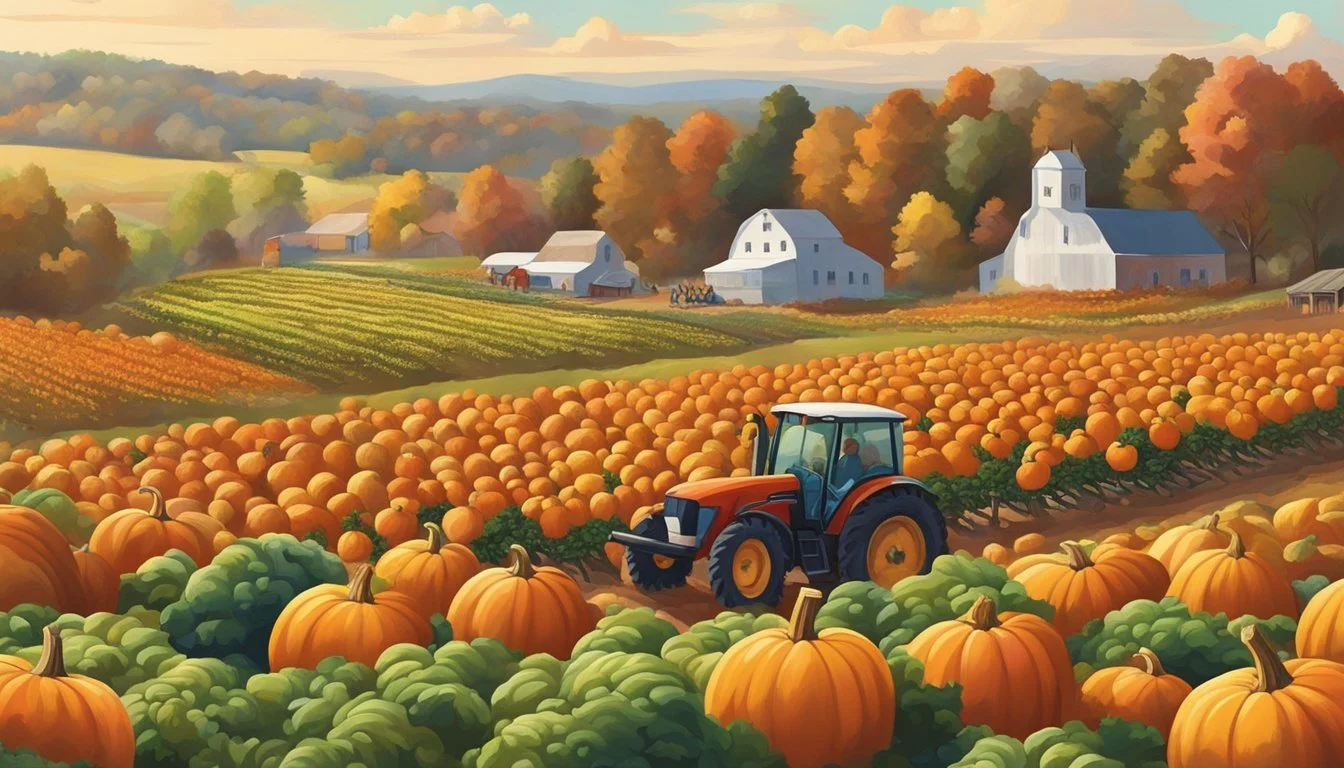Virginia Seasonal Fruit & Vegetables in November
Your Guide to Fresh Produce
This Article is Part of our Virginia Seasonal Fruit & Veg Calendar
In Virginia, the transition from fall to winter marks a distinct shift in seasonal produce offerings. As November rolls in, the harvest accordantly brings a variety of fruits and vegetables that are at their peak. The state's rich soil and moderate climate contribute to the cultivation of these products, making it an ideal time for residents and visitors alike to enjoy the bounty of the season.
Vegetables such as beets, which are available year-round, find their prime in the fall, often sold with their greens attached, hinting at their freshness. Broccoli, a staple in many kitchens, experiences a resurgence in harvest during the cooler months of October and November. The leafier and more flavorful broccoli raab also makes its appearance, offering a bitter edge that mellows when blanched.
Fruits, while fewer in the cool November climate, are nonetheless represented by the tail end of apple varieties that have been maturing throughout the year. These late-season apples are often perfect for both eating raw and for use in various culinary applications, such as pies and sauces. With seasonal consumption, Virginia residents can take advantage of the fresh flavors and nutritional content that these fruits and vegetables provide.
Seasonal Overview
November in Virginia marks the transition from the colorful harvests of autumn to the heartier selections that can withstand the onset of winter. The state's rich agricultural heritage continues to thrive during this month, offering a bounty that is essential for local cuisine and festivities.
Importance of Seasonality
Understanding seasonality is crucial as it ensures the consumption of produce when it's at its peak in both flavor and nutritional value. It also supports local farming communities and minimizes environmental impact due to reduced transportation and storage.
November's Seasonal Characteristics
In November, Virginia's farmers markets showcase produce that reflects the characteristics of late autumn and the approach of winter. Root vegetables and hardy greens are prominent, and they include:
Root Vegetables:
Beets
Turnips
Sweet potatoes (What wine goes well with potatoes?)
Hardy Greens:
Collard greens
In terms of fruits, apples and Asian pears are still widely available, harvested in late autumn and able to be stored well into the winter months. They offer versatility in culinary applications, from fresh consumption to use in pies and preserves.
Fruits in Season
In Virginia, November marks the season for a diverse array of fruits, where apples and pears take center stage due to their variety and peak ripeness. It is also a time for some less common fruits like persimmons and pomegranates to shine on the seasonal produce stage.
Apple Varieties
Virginia's November chill ushers in the harvest of several apple varieties which are at their peak, with options ranging from the crisp Fuji to the tart Granny Smith. Consumers can also enjoy the sweet nuances of Gala apples or the balanced flavor of Golden Delicious. Furthermore, the heirloom variety, Virginia Gold, unique to the area, becomes readily available.
Fuji
Granny Smith
Gala
Golden Delicious
Virginia Gold
Pears and Their Profiles
Much like apples, pears offer a range of textures and flavors. The buttery Bartlett pears are perfect for both eating raw and cooking, while the crunchy and subtly sweet Bosc pears hold their shape well, making them ideal for baking. Anjou pears, known for their juiciness, continue to be a favorite choice for a fresh fruit snack.
Bartlett (buttery and versatile)
Bosc (crunchy and subtly sweet)
Anjou (juicy, ideal for snacking)
Other Seasonal Fruits
While apples and pears dominate the scene, other fruits also deserve attention. Persimmons, with their honey-like flavor, become ripe after the first frost, making them a delightful treat. Pomegranates, with their jewel-like seeds, offer a burst of tart and sweet flavors, and are typically harvested in fall. Lastly, cranberries, often associated with holiday dishes, become available during this month.
Persimmons (honey flavored)
Pomegranates (tart and sweet)
Cranberries (ideal for holiday dishes)
Vegetables in Season
In November, Virginia's harvest offers a rich assortment of vegetables, from hearty root vegetables to nutritious leafy greens and a variety of squash. These selections are not only seasonal highlights but also offer flavors and nutritional benefits ideal for autumnal recipes.
Root Vegetables
Root vegetables thrive in the cooler temperatures of November. They are staples that can be found in many Virginia markets.
Sweet potatoes: Characterized by their rich orange flesh, sweet potatoes are a nutritious choice, high in beta-carotene and vitamin C.
Turnips: These are versatile, with a slightly peppery flavor when raw and a milder taste when cooked.
Beets: Deeply colored and earthy, beets are full of fiber and essential nutrients like folate.
Garlic: A foundational flavor for countless recipes, Virginia-grown garlic is harvested and available this time of year.
Leafy Greens
Leafy greens are in abundance in November, providing a wealth of vitamins and minerals.
Kale: This hearty green is a cold-weather favorite, known for its health benefits and versatility in dishes.
Chard: With its broad, colorful leaves, chard is a flavorful green that can be prepared in a variety of ways, from sautéed to added fresh in salads.
Squash Varieties
Winter squash varieties, with their thick skins and robust flavors, are ideal for storing and using throughout the colder months.
Winter squash: A broad category that includes varieties like butternut, acorn, and spaghetti squash, offering a sweet, nutty flavor and a plethora of culinary uses.
Pumpkin: A November icon, pumpkins are more than just jack-o-lantern material; they’re delicious in pies, soups, and roasted side dishes.
Other notable vegetables such as cauliflower and celery (how long does celery last?) are also available. Cauliflower especially is versatile, perfect for roasting, mashing, or as a low-carb substitute. Celery brings a crisp texture and distinct flavor to salads and mirepoix bases. These vegetables contribute to the rich diversity of produce available to Virginians in November.
Herbs and Seasonings
In the November chill of Virginia, certain herbs and seasonings reach their prime, providing both robust flavors and aromatic delights to the culinary experience. Home gardeners and local farms harvest a variety of seasonings during this time, ready to enhance the palate of any dish.
Sage, a perennial favorite, stands out among the herbs with its strong, somewhat peppery flavor. Its grayish-green leaves are typically used in Thanksgiving turkey stuffing and other savory dishes. This herb is not only prized for its culinary uses but also for its aromatic properties, which lend a comforting scent to kitchens and dining areas.
Other herbs that might still flourish in the cooler November climate include:
Rosemary: With its pine-like fragrance and needles, rosemary is ideal for roasting meats and root vegetables.
Thyme: This versatile herb offers a subtle, earthy flavor to soups, stews, and roasted foods.
Parsley: Often used as a garnish, it also provides a fresh, clean taste to salads and entrees.
Beyond these individual herbs, the category of aromatics generally refers to a combination of vegetables and herbs that are sautéed at the beginning of cooking to form a flavor base for a variety of dishes. In Virginia's November, aromatic mixes often include onions, carrots, and celery alongside the aforementioned herbs, creating a mirepoix or soffritto that is an essential component in many Thanksgiving and holiday recipes.
As these herbs and seasonings are harvested in the latter part of the year, they typically offer a fresher and more potent flavor compared to off-season counterparts. Chefs and home cooks alike value these November-picked herbs for their ability to elevate dishes with their freshness and depth of flavor.
Culinary Applications
In Virginia, November brings a variety of seasonal fruits and vegetables to the table, offering a rich palette for culinary exploration. The flavors range from sweet and tart to earthy, providing ample opportunity for creating hearty and comforting dishes.
Recipes & Preparations
Virginia's autumn harvest includes fruits and vegetables that are versatile in the kitchen. Apples, with their balance of sweet and tart, are perfect for both desserts and savory preparations. They can be baked into pies or turned into applesauce. Sweet potatoes, another November staple, can be transformed into creamy soups, spiced and roasted as a side, or used in casseroles.
Apple recipes:
Apple Pie
Homemade Applesauce
Apple Crisp
Sweet Potato recipes:
Sweet Potato Casserole
Roasted Sweet Potatoes with Honey and Cinnamon
Sweet Potato Soup
Leafy greens, such as kale, are often sautéed or used raw in salads for a nutritious crunch. Root vegetables like beets offer an earthy flavor and can be roasted to enhance their natural sweetness or used in salads for color and texture.
Kale preparations:
Sautéed Kale with Garlic
Raw Kale Salad with Lemon Dressing
Kale Chips
Beet preparations:
Roasted Beetroot Salad with Goat Cheese
Beet and Carrot Gratin
Pairings & Flavors
When considering pairings and flavors for Virginia's November produce, chefs should note how autumnal ingredients like squash and Brussels sprouts (how long do brussels sprouts last?) can complement both sweet and savory profiles. Squashes can be enhanced with spices like cinnamon and nutmeg (how long does nutmeg last?), or paired with sweeter elements like maple syrup. Brussels sprouts pair well with savory and fatty flavors, such as bacon or roasted nuts.
Squash flavor pairings:
Squash with Cinnamon and Brown Sugar
Butternut Squash (how long does butternut squash last?) Soup with a hint of Nutmeg
Roasted Acorn Squash with Maple Syrup Glaze
Brussels sprouts flavor pairings:
Brussels Sprouts with Crispy Bacon
Roasted Brussels Sprouts with Almonds
Brussels Sprouts in Balsamic Reduction
Cranberries, prevalent in November, can be used to create tart sauces or compotes that complement roasted meats (What wine goes well with roasted meats?), or they can be added to smoothies for a sharp taste contrast. Herbs such as sage and rosemary bring an aromatic depth to many dishes, including roasted vegetables and stuffings.
Cranberry applications:
Cranberry Sauce for Turkey
Cranberry Orange Smoothie
Cranberry Walnut Salad
Herb uses:
Rosemary Roasted Potatoes
Sage-infused Stuffing for Poultry
Herbed Butternut Squash
Using fresh, seasonal produce from Virginia, such as apples, sweet potatoes, kale, beets, squash, Brussels sprouts, and cranberries, allows for the creation of flavorsome and nourishing meals that celebrate the season's bounty.
Nutritional Benefits
In November, Virginia's seasonal produce offers an array of nutritional benefits integral to a healthy diet. Many fruits and vegetables available during this time are rich in fiber, which is essential for digestive health. They also provide a variety of nutrients that contribute to overall wellness.
For instance, leafy greens such as kale and Swiss chard, which thrive in Virginia's cooler November climate, are excellent sources of vitamin C. This vitamin is a powerful antioxidant known to bolster the immune system, especially beneficial during the colder months.
Root vegetables, including sweet potatoes and carrots, dominate the seasonal offerings. Their high fiber content not only aids digestion but also helps maintain blood sugar levels. Sweet potatoes are notably high in vitamins A and C, boasting an impressive nutrient profile.
Brussels sprouts and winter squash, also peaking in November, come packed with antioxidants. These substances play a key role in reducing oxidative stress in the body, thus preventing chronic diseases. Additionally, they contain several nutrients vital for maintaining strong bodily functions.
Consuming these fruits and vegetables from local Virginia farms ensures you ingest fresh produce with optimal nutrient content. The closer one eats to the time of harvest, the more nutrient-dense and flavorful the food will be. A diet inclusive of seasonal produce not only supports Virginia agriculture but is a foundational component of a healthy lifestyle.
Agricultural Practices
Virginia’s agricultural sector places a strong emphasis on both sustainable farming practices and organic cultivation to ensure a healthy supply of fruits and vegetables, like those harvested in November.
Sustainable Farming
Virginia farms are increasingly adopting sustainable farming practices. Sustainable agriculture in Virginia focuses on conserving water, reducing pesticide use, and employing crop rotation and cover cropping to maintain soil health. These practices not only support the ecosystem but also aim to provide a long-term viability for agriculture in the United States. For instance, many Virginia farmers utilize:
Integrated Pest Management (IPM): A systematic approach to manage pests focusing on long-term prevention through a combination of techniques such as biological control, habitat manipulation, and modification of cultural practices.
Water Management Techniques: Techniques such as drip irrigation to conserve water usage.
Organic Cultivation
Organic cultivation in Virginia refers to the way farmers grow and process agricultural products, including fruits, vegetables, grains, dairy, and meat. Organic farmers in Virginia must adhere to guidelines set forth by the United States Department of Agriculture (USDA). These standards prohibit the use of most synthetic fertilizers and pesticides, genetically modified organisms (GMOs), and growth hormones. Key aspects include:
USDA Certification: Virginia farms must obtain USDA organic certification to be marketed as organic.
Natural Fertilizers: The use of compost and animal manure as natural soil amendments is commonplace.
Crop Diversity: A varied crop selection helps to break pest cycles and improves soil health.









